Long-range hunting continues to gain in popularity. But just because you want to go long doesn’t mean dropping in bullets at 1,000 yards. Most deer hunters, for example, take their shots at 100 yards or less. Yet, if those same hunters could extend their range to 400 yards? Their chances at filling their tags would go up greatly.
And you don’t have buy a $4,000 custom rifle topped with a scope that costs the same to be in the longer-range game. In fact, most of today’s mid-priced bolt-action rifles can effectively hit a deer’s eight- to ten-inch diameter vital zone at 400 yards—when paired with a quality optic and first-rate ammunition. The same goes for their AR-10 cousins.
You, too, can be a 400-yard deer hunter–with some summer-time preparation to get ready for the fall.
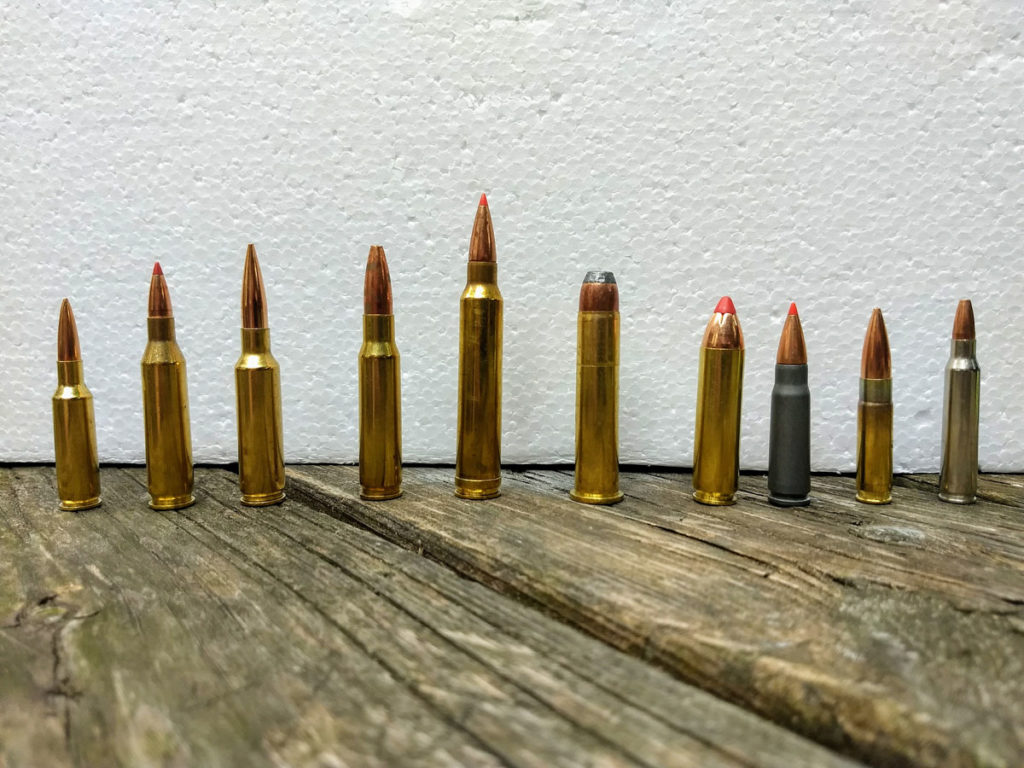
From left to right, calibers for 400-yard deer hunting include, YES: .224 Valkyrie, .243 Win, 6.5 Creedmoor, .308 Win, and 300 Win Mag; NO: 45-70Govt, 7.62x39mm, 300 BLK., and .223 Rem.
Caliber Choices You’ll need a rifle in a caliber with enough punch to drop a deer at 400 yards; examine general ballistic charts and you’ll find that most calibers starting with .243 Win and up will more than do the job. Exceptions: 30-30 Win, 45-70 Govt., many of the larger bore AR’s (.45o Bushmaster, for example), and yes, the Rem .223 and 7.62x39mm. These rounds simply don’t have the needed energy at this range.
One exception in the other direction: the new .224 Valkyrie, which might seem too small based on bullet diameter. Yet, when loaded with 90-grain soft-point bullets, the round is a flat-shooting screamer, ballistically speaking, with the power for 400-yard deer hunting.
Optics Plenty of budget scopes work fine for hunting—at 150 yards or less, in bright sunlight, and with the animal patiently standing broadside. But add in a couple hundred yards of distance and hazy conditions, and these same scopes usually produce blurry images. Often, their reticles are too large at distance, too, for a precise shot.
For a 400-yard rig, you’re looking at rifle scopes that start at $500 and up. You will also want a scope that had a reticle with holdover points, either in Mils or MOA graduations. Parallax adjustment is a nice feature, too.
Magnification? Much of that will depend on your eyes. When my shooting is in the 300- to 400-yard range, I find myself turning my rifle scope up to the 10x to 12x range, depending on light and other environmental conditions. So, for me, a scope with a 3x to 15x magnification range works fine.
Range Time My rule of thumb: if a rifle can print MOA or better groups at 100 yards, it will work at 400 yards. But if you can only do two-inch groups at 100 yards? Now you are at a spread of eight-inches or more at 400 yards, and that’s an open invitation to wound an animal.
So, get to the range and see what your current hunting rifle can do on paper.
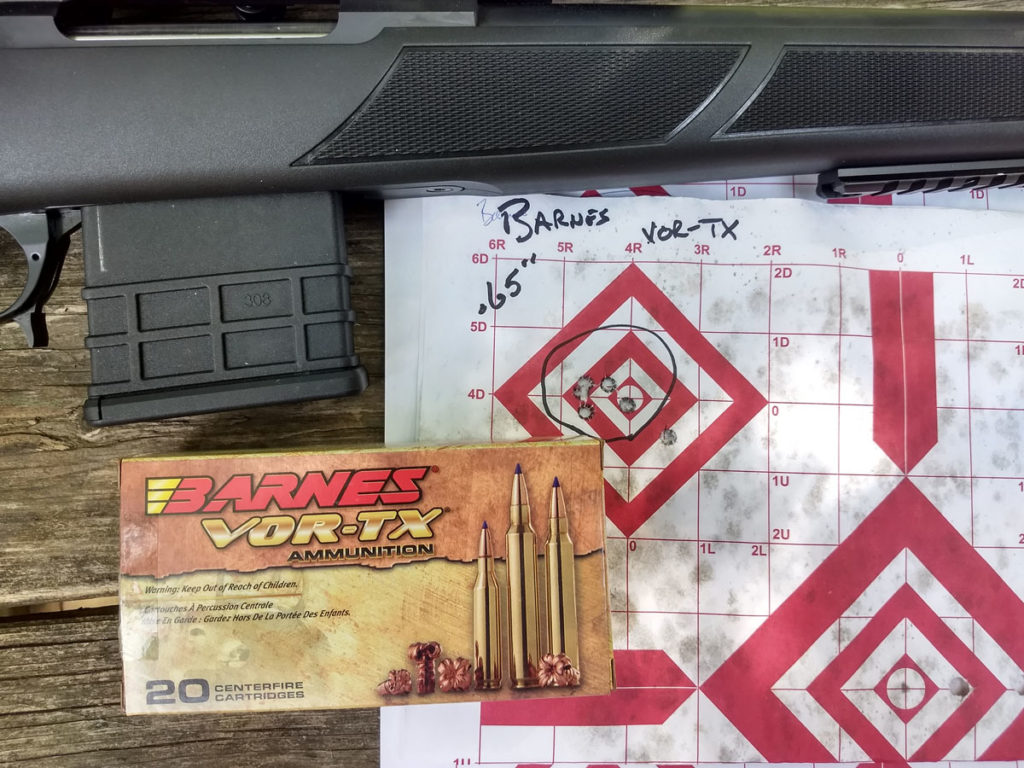
When your rifle-optic-ammo rig prints sub-MOA at 100 yards? It’s probably capable of the 400-yard shot.
Ammunition Many ammunition makers are producing long-range hunting ammo, using bullets and powders to specifically produce superior accuracy at distances. I was leery of such ammunition and wondered if it really was better accuracy-wise or just a way for ammo makers to charge an additional $15 per box of ammo.
But I’ve found that the standard deer hunting rounds print 1.5-inch or larger groups at 100 yards. Meantime, these “long-range” cousins actually shrink those groups to .80- to .50 inches—with the very same rifles.
Much like the budget scopes, the standard deer hunting ammo is fine for shots out to 100 to 150 yards. But increase that shooting distance, and you will want to use the better–and admittedly more expensive—ammunition.
Shooting Positions Once you decide on a rifle and scope combo that’s pegging tight groups, it’s time to start shooting from various positions beyond the bench. Go prone, for example, and fire off 10 rounds using your backpack as a rest. Try some shots kneeling, with the shooting bench to support your shooting arm as a way to mimic that large rock or downed log you might find afield.
Bring your shooting sticks to the range and shoot from them sitting with your back against the shooting bench. If you have tall sticks, practice standing shots.
Take it all one step further and go afield with your rifle and shooting sticks and see what it all feels like to set up a shot here. You don’t even need to shoot (although that would be very good practice, too). The point is to experience actual field conditions to acquire a good idea of what it might take to set up a stable shot.
With shooting sticks, for example, stable requires a solid base and support for you shooting arm. Establishing that arm support may take some creativity. If you are sitting behind the sticks, see if a backpack under the elbow will get the job done. Maybe your back to a rock or deadfall will provide stability. When I am setting up for a standing shot with sticks at distance, I try to find a tree I can either lean into for support or back into for elbow stability.
Ballistic Calculators Do yourself a big favor and start using a ballistic calculator, many of which can be downloaded onto your cell phone as an app. There are many very good calculators out there, including several offered for free from ammunition manufacturers like Federal and Hornady, as well as for-fee calculators.
In prepping for a recent free-range Axis deer, I used the Advanced App from Ballistic. My process is to get to the range and find out which hunting ammo is producing the best groups. Then, I start plugging my variables into the app.
In this case, once I had selected my ammo for the Axis hunt—Barnes VOR-TX in 6.5 Creedmoor firing a 120-grain TTSX bullet–I built my shooting profile on the Ballistic app I’d downloaded onto my iPad. I input my caliber and bullet weight, the 100-yard zero, and the atmospheric conditions which existed when I was doing my shooting.
Next, I chronographed 10 rounds to arrive at the average muzzle velocity and added that velocity to my Ballistic profile.
Now, I plugged in a 200-yard zero into Ballistic (which requires less holdover for the 400-yard shot), and it calculated my rifle would shoot two-inches high at 100 yards with a 200-yard zero. I adjusted my scope accordingly and shot a nice 100-yard group clustered two inches above the bullseye.
(I would’ve just shot a group at 200-yards to verify, but my shooting club only has 100-yard rifle ranges.)
Once I got to the Texas Hill Country for my Axis hunt, I plugged in the local atmospheric conditions, including temperature, barometric pressure, and altitude, which reset my bullet drop points and needed MOA adjustments out to 400 yards. Then, I created a range card of sorts by writing down those trajectory points, from 0 yards out to 400 yards, on a piece of notebook paper.
Last, I plugged in potential winds of 5MPH, 10MPH, and 15MPH into my Ballistic app to see what the drifts were at various distances and noted them on the back of my dope chart. I could have added more wind speeds, but I figure if the wind is 20MPH or better, I’m not taking that shot. Too iffy, in my experience.
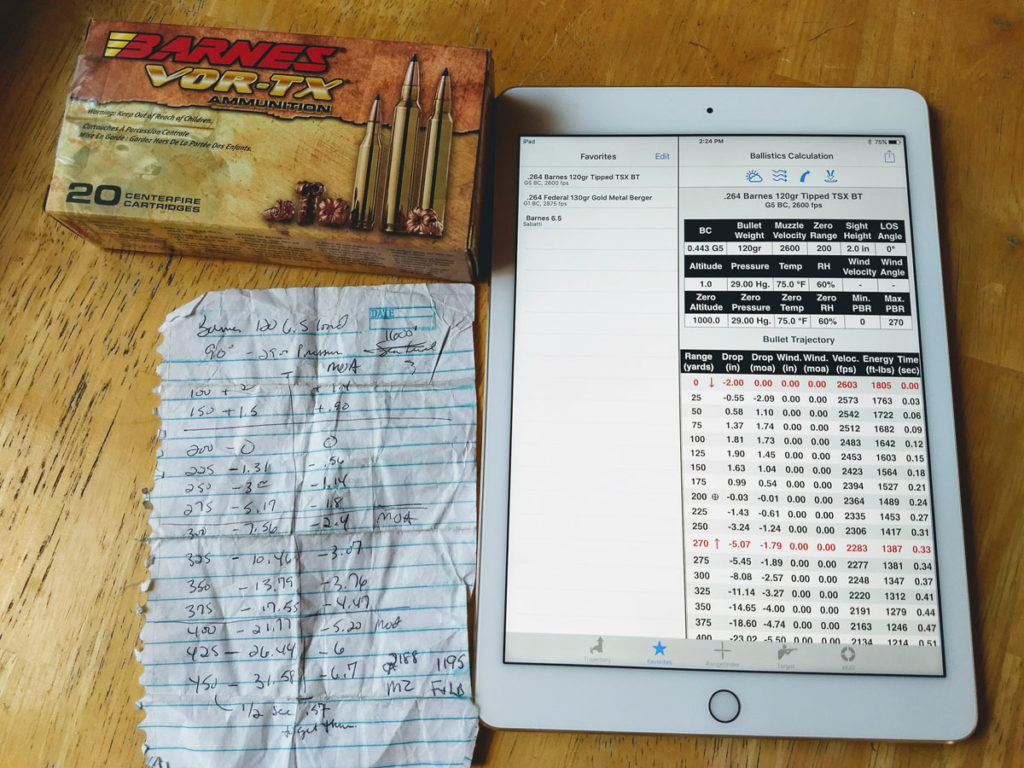
Author’s iPad with Ballistic app downloaded and set up for the trajectory profile of 6.5 Creedmoor Barnes VOR-TX ammunition, used on his recent Axis deer hunt, plus his notebook paper “range card.”
Range Finders Invest in a solid range finder. The bullet profile you create with your ballistic calculator will only work if you know the actual field distances.
Practice with that range finder, too, at the range and afield. I’ve found that distances can be very deceiving. When the landscape is nice and level, for example, my distance estimates (verified by my range finder) are pretty much spot on out to 300 yards.
But when the location’s hilly or I am looking across canyons? My eyes and brain will insist that black rock is 300 yards away. My range finder, though, usually puts the rock closer to 200 yards.
Conclusion Becoming a 400-yard deer hunter does take time, practice and a certain financial investment. But there’s a great sense of accomplishment when you drop that 10-pointer standing at the end of the bean field. Especially when the buck was at a distance you wouldn’t have considered possible before your work to become a 400-yard deer hunter.
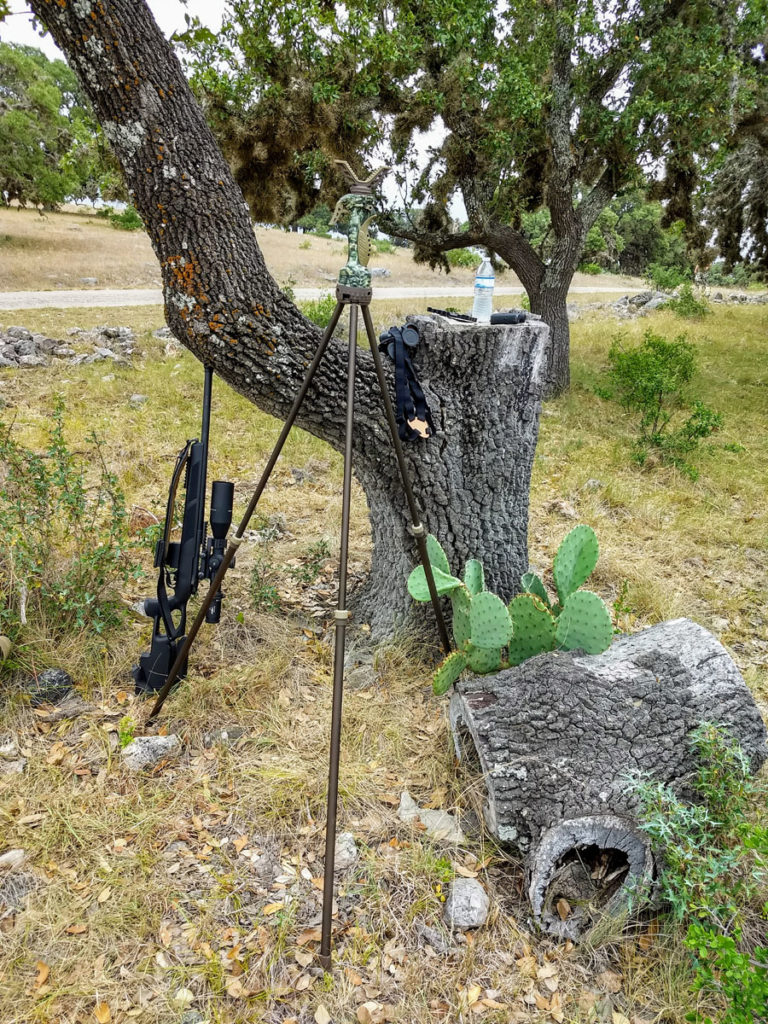
Actual set up from author’s recent long-range hunt, using Jim Shockey Shooting sticks from Primos. When leaned back into it, the tree in back provided added stability.

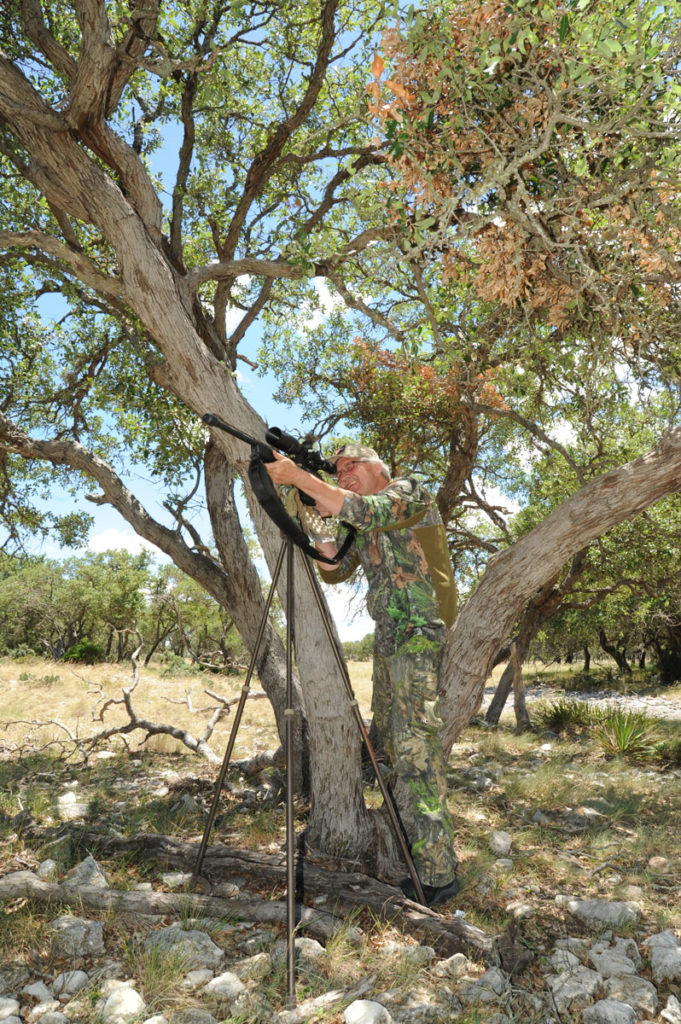
There were plenty of calibers left out. The incredible 06 and the 270 Win are just a few. I understand you only listed a few of the popular loads and hurt a few feelings. They’ll get over it. My opinion is any rifle of .25 caliber to .30 caliber pushing a 100gr or larger that you’ve had for years and capable of MOA accuracy is suitable for a 400 yard humane kill on whitetail/mule deer size game. The optic needed is personal preference and what you train with. I’ve been using the Vortex 6x24x50mm. Atop a RPR in 6.5 Creedmoor. Why shoot at 400 when you can shoot at 200 or closer. Another opinion of mine. Train at all reasonable distances so when that 175” whitetail shows himself, you’ll be confident you’ll handle him. Semper Fi.
25-06 nuff said
I hand load my 30:06 with 165g Sierra Boat tails and it shoots sub moa at 100 yards. I’m totally comfortable shooting at 400 yards with this rifle and was disappointed you didn’t include this caliber in your article. I’ve been shooting over sixty years and have killed deer with this rifle that were running flat out at 300 yards but then I grew up with a rifle in my hand. I’ve never lost or wounded a deer with this rig either
Regarding the new .224 Valkyrie loaded with 90-grain soft-point bullets… I DO NOT feel this cartridge should be used for 400 yard shots on deer size animals, but it’s an excellent Varmint Killer. Although the round is a flat-shooting screamer as you claim, it’s actually inferior to the old .22/250 which again is not a very good cartridge for either short or long range deer hunting. I will not even get into rate of twits on barrels because loading a 90 grain projectile in a .22/250 could result in severe stabilization issues. Yes, both cartridges will get the job done but a perfect shot placement would be the key factor and in many cases a higher percentage of animals would also end up being wounded rather than killed. So why use either of these less effective lower energy rounds for deer hunting when there are dozens of superior cartridges that are capable of placing heavier projectiles with far more energy on the game that you are hunting. The only reason that the .224 Valkyre exists is because it was designed to be used on an AR type platform without massive modifications and since the .22/250 is based on the larger diameter .308 head style case, that old and many times tested .22/250 would not work on the AR platform without a major receiver redesign. If you are concerned about the recoil differences… I suggest you give up hunting and head to your local butcher shop for nourishment which in reality will cost you far less for that meal…
I ve been shooting a, 257 Roberts for years now,. Another really good 400 yard deer rifle. I noted you used the 243 as an example,. The 25 Roberts is better. But, in reality, I guess there is alot if rifles that are good for a 400 yard shot. It simply comes down to what your comfortable with and and Shoot strate.
Ok but if you are shooting the 224 Valkyrie in 90gr plus be sure your barrel twist is 1:6.5 or better right? Most for sale are 1:7 just a thought.
Shooting deer at 400-500 yards is FAR from “poor hunting” or irresponsible shooting out here where I live. Hear in the rolling hills and breaks of the Snake river we hunt large bodied mile deer where there is not a single, solitary tree or rock or even shrub for miles and miles. Just CRP grasslands and wheat fields in different stages of growth and harvest. Using terrain as our only cover, we consider ourselves fortunate to get within 300 yards and shooting out to 400 or 500 yards is simply a necessity and part and parcel of hunting in this region. No one uses Redfield or Weaver and even Leupold is falling out of favor for Vortex and other brands. 4.5-14 scopes are common, as are 4-16’s and favored calibers are 7 Mag, .264 Winchester Magnum, 26 Nosler, 257 WBY and the like. Everyone packs shooting sticks, we practice from them in the sitting position with a real shooting sling (not just a carry strap) and make clean kills out to 500 yards and a little beyond regularly. Your region is probably very diffferent, allowing one to stalk and such but out here you either go long or go home.
30-06, 150 Hornady SST shoots farther and flatter than most folks can shoot.
You left out the outstanding .270, I have dropped several deer at or around 400-450 yards with mine. The 270 is a speedy, flat shooter that is perfect for deer sized game.
The article should be entitled “400 Yard Deer Shooter” not “Hunter.” Hunters always try to minimize distance to get as close to their game as possible. Too many things can go wrong at longer ranges. Promoting long-range shooting at big game is like advocating sky-busting at ducks. The more hunters respect their quarry, the more they will use wind-in-the-face stealth to get as close as they can before taking the shot. Those too lazy to give fair chase and close the distance are giving hunting a bad name.
Reading your article, I noticed that at least four of my favorite calibers were omitted ( 30.06, 7mm Mag, .280 Rem/7mm Express and even the old 7mm Mauser) and there are also many more not mentioned that will adequately do the job… I am now a senior citizen but back in the early 1950’s was once a Pennsylvania Boy who started hunting and riding a bicycle at about the same age. I have also shot in many 1,000 yard competition matches during my 60+ years of trigger pulling and am fully aware that 400 yard shots are not out of the question if you know what you are doing and are using the right cartridge… and many of today’s modern firearms are fully capable of 6 inch or better groups at 500 yards off a bench. In fact about 50 years ago I took out an 8 point buck with a Remington 700 ADL… 7mm Magnum topped with an old Redfield Widefield 4×12 scope using one of my match grade Handloaded 162 gr Hornady BTHP’s at a distance of around 580 yards … which was across a valley between two mountains. The Buck dropped with one shot in under 10 feet from where he was hit in the vitals. Now I’m not saying that an inexperienced shooter should try such long shots but if it was possible almost a half century ago… it surely is possible today with all the many improvements in firearms, powders and ammunition.
I’ll stick with my 7mm mag topped with my 1970ish Redfield wide field 3×9 loaded with my own proven reloads, thank you.
PA hunter here. Deer and Bear. 7MM REM MAG BEST DEER/BEAR CARTRIDGE EVER MADE!!!
Hate to see articles encouraging shots at game that are way beyond the capability of 99% of hunters. Bench accuracy is not field hunting conditions or state of mind. Huge margins of error resulting in wounded game, low information on background. In short, irresponsible hunting. Not good for the game or the sport, not to mention huntings reputation.